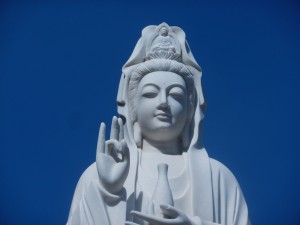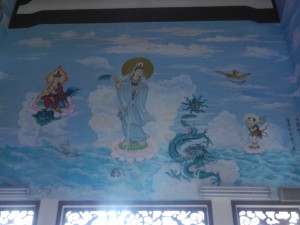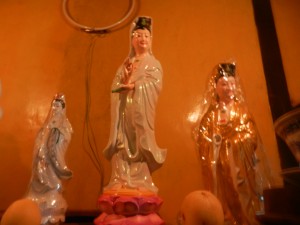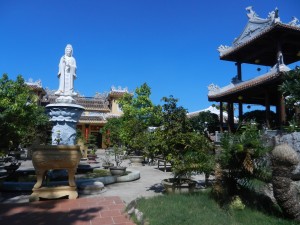The media have often portrayed Vietnamese as tough people who have earned their stripes fighting for their independence for over 2,000 years. But I saw another side of them too.
This other side inspired a lot of great art, which isn’t in any books I’ve seen. But you can discover it here.
Many temples that I saw in Vietnam were fronted by a statue of Quan Am–better known by the Chinese name, Quan Yin.
Quan Yin represents the Buddha’s compassion. Indians had called this deity Avalokitesvara. When the Chinese imported Buddhism, they conflated this deity with Daoist immortals associated with the West and called it Quan Yin–who takes departing souls to the western Paradise.
The face in the 1st photo is as idealized as a classical Athenian sculpture’s, and the bottom one is as kindly as a mother. But if I see either one whenever I leave this world, I’ll know that I’m in good hands.
Quan Yin actually doesn’t need to be a woman. This deity can take any form to embody the Buddha’s compassion. But Chinese and Vietnamese often turned Quan Yin into a model of feminine grace and motherly love, as Westerners did with Mary.
But in Vietnam, I found several of the most graceful images of the feminine I’ve ever seen. They perfectly balance the masculine force that I saw in many Buddha statues at the main altar.
The statues in the above shot are right by the tough guys in Hue’s Bao Quoc Pagoda.
Here’s a view of the first Quan Yin statue in this post from a distance. I saw this type of sight in one Vietnamese temple after another–nature’s abundant growth fused with buildings’ gentle colors and forms. Quan fits in perfectly. Though she rises from a lotus to take souls to Paradise, she meshes with her environment into a full affirmation of life in this world.
Vietnam’s history of fighting invading armies and enduring corrupt politics has given it many models of heroism. But there’s all this enchantment by their sides. The tough and the gentle are very well-developed in Vietnamese culture. They mix in so many varieties that you’d need several lifetimes to explore them. The media haven’t come close to exposing Vietnam’s cultural wealth.







Comments on this entry are closed.